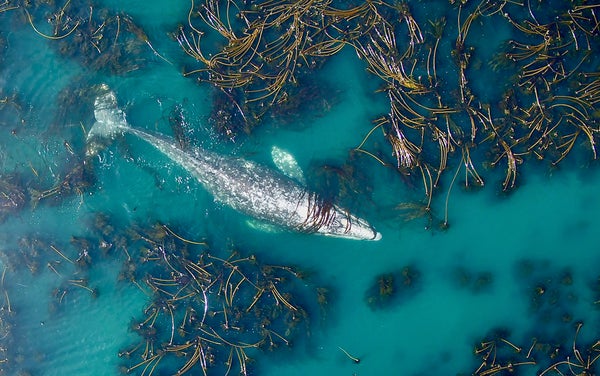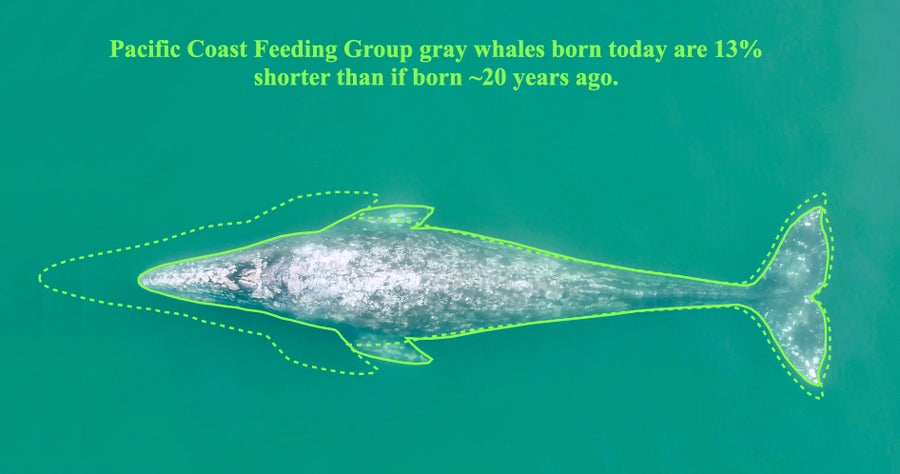These Gray Whales Are Shrinking and Scientists Aren’t Sure Why
These Gray Whales Are Shrinking and Scientists Aren’t Sure Why
Gray whales in a small group that sticks close to the shores of the Pacific Northwest appear to be shrinking—and shockingly quickly

Drone image of a Pacific Coast Feeding Group gray whale.
Geospatial Ecology of Marine Megafauna (GEMM) Lab, Marine Mammal Institute, Oregon State University
Something very strange is happening to a group of about 200 whales plying the waters off the coast of the Pacific Northwest.
These gray whales (Eschrichtius robustus) are just a small cohort of the 14,500 individuals swimming through the northeastern Pacific Ocean. They’re already quite unusual compared with their neighbors: members of the Pacific Coast Feeding Group, as the band is dubbed, are smaller and slimmer, and they eat different food that they catch using different techniques, all while sticking to the coasts of northern California, Oregon, Washington State and British Columbia. And now research published on June 7 in the journal Global Change Biology finds that these whales may not just be smaller than their compatriots—they may also be shrinking.
“We kind of stumbled upon this change in size,” says Enrico Pirotta, a quantitative ecologist at the University of St. Andrews in Scotland and a co-author of the paper. “I wasn’t expecting the decline [in size] at all.”
On supporting science journalism
If you’re enjoying this article, consider supporting our award-winning journalism by subscribing. By purchasing a subscription you are helping to ensure the future of impactful stories about the discoveries and ideas shaping our world today.
Pirotta and his colleagues based their findings on data gathered by drones that the team flew above gray whales between 2016 and 2022. The drones snapped photographs of 130 different animals, which scientists matched to databases that have tracked every whale in the group for decades and include information on when they were born or arrived in the area. “This study relies on knowing these animals for much longer than just the years for which it studies them,” Pirotta says.

This schematic shows the difference in length between a PCFG gray whale born in 2020 vs one born prior to the year 2000. OSU researchers determined that a full-grown PCFG gray whale born in 2020 is expected to reach an adult body length that is 1.65 meters (about 5 feet, 5 inches) shorter than a gray whale born prior to 2000. For PCFG gray whales that grow to be 38-41 feet long at full maturity, that accounts for a loss of more than 13% of their total length.
Geospatial Ecology of Marine Megafauna (GEMM) Lab, Marine Mammal Institute, Oregon State University
The researchers fed the information into a computer model to turn the drone observations into measures of each animal’s asymptotic length—an estimate of the maximum length an organism could achieve. And those data revealed a shocking trend: beginning with whales born around 2000, the asymptotic length of animals in this group has been shrinking by more than three inches per year from a baseline of about 40 feet.
“It is a very surprising finding that it’s that dramatic of a change over time,” says Aimée Lang, a biologist at the National Oceanic and Atmospheric Administration’s Southwest Fisheries Science Center, who wasn’t involved in the new research. In particular, she notes, the new results reveal a proportionally larger decline in size over time than previous research that studied similar trends in other whales.
Although such changes in a subpopulation sometimes herald a new species in the process of developing, both Pirotta and Lang say that’s likely not the case with these gray whales. Because scientists haven’t detected any genetic changes in the coastal clique, it’s likely that the size decline instead is a flexible response to changing conditions, they say.
Pirotta and his colleagues looked at two environmental factors that they thought might impact whale size: the state of the Pacific Decadal Oscillation, an El Niño–like cycle of warm and cool temperatures across the full ocean basin, and shorter-term patterns in local nutrient upwelling. In both cases, a whale’s future size seemed to be most closely associated with the conditions its mother experienced before giving birth, although the scientists can’t say anything about whether these factors are causing the shrinkage.
Researchers aren’t yet sure how concerned to be about the small group of mysteriously shrinking whales or about the Northern Pacific’s gray whales more generally. Pirotta worries that as whales get smaller, they may also birth fewer calves or struggle to feed, although this study didn’t look for such effects. “It’s kind of a warning signal to me that something is not quite right,” he says.
Lang says she’d be interested in future research looking for a similar shrinking trend in the main population of gray whales, as well as studies of any possible consequences of the size change among the coastal whales, which, she says, are vulnerable to upheaval because their population is so small.
“If these findings have longer-term impacts on the persistence of that group, that would really be a concern,” Lang says. “For me, the jury would still be out until we see a little bit more about whether this decline is actually having impacts on the group’s persistence.”


